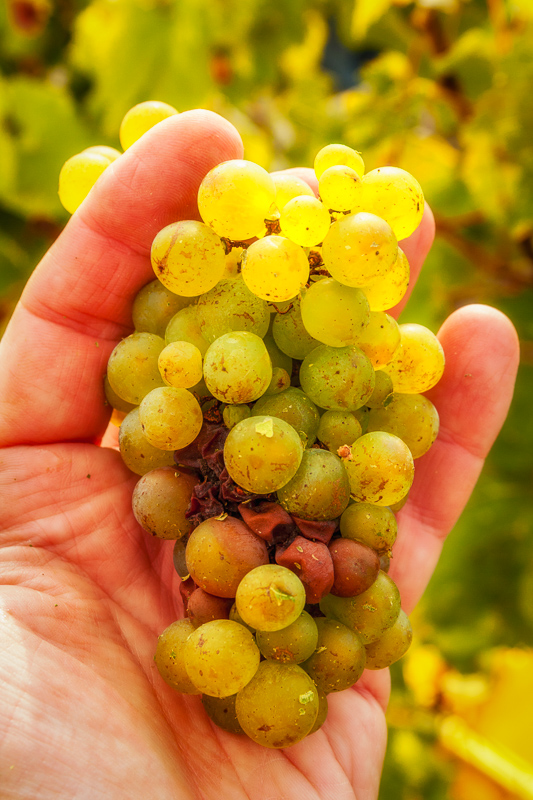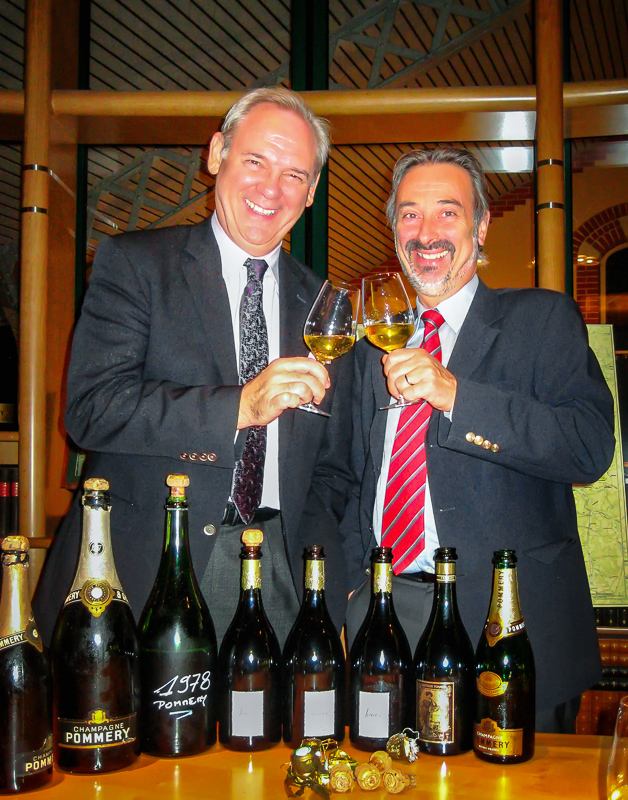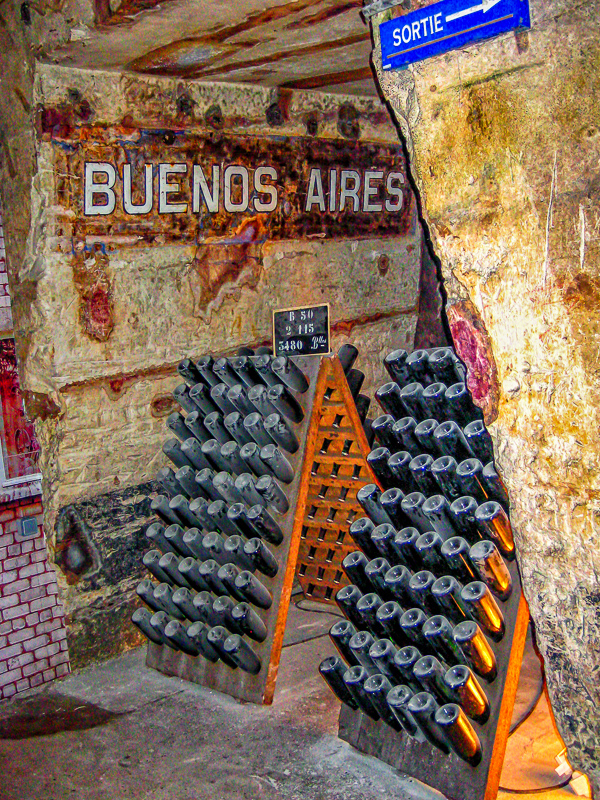The hardest sell I face in sharing wine with friends is persuading them to try a sweet wine. “Sweet wine? Ugh,” they say. “Real wine is dry!” But the truth is many wine drinkers, and especially those new to the beverage, actually prefer wine with a bit of sugar, they just don’t know it’s sweet. White zinfandel? Loaded with sugar. Many chardonnays? They definitely have some “residual sugar,” grape sugar left behind when fermentation stops. It’s often below the threshold where our palates identify it as sugar (less than three grams of sugar per liter of wine is hard to identify), but it is there.
And, what is wrong with sugar? Like any element, it can be used for good reasons or with a less than laudable intent. In wine, sugar can be used to mask faults, like wine that is too acidic, or wine made from under-ripe grapes that don’t have enough sugar to make a sufficient amount of alcohol. In many countries it is perfectly legal to add sugar to the pressed grapes before fermentation to increase the amount of alcohol in the final product, and sugar balances the acidity that is intrusive in wines that were made from under-ripe grapes. It gives added texture and a feeling of fruitiness to wines that may seem a bit thin or lacking in flavor… in other words, it’s a Band-Aid for wines the industry does not want you to know are flawed.
 Chardonnay, one of the three grapes that struggle to ripen in Champagne (Photo: Lyn Farmer)
Chardonnay, one of the three grapes that struggle to ripen in Champagne (Photo: Lyn Farmer) But sugar also plays an absolutely key and very positive role in very well made wine, like Champagne. A bit of sugar is almost always added to Champagne just before bottling to give it balance and body. In fact, Champagne sees sugar three times in its life: First, it has the sugar that occurs naturally in grapes as the fruit ripens. That sugar is fermented by yeast to make a dry (i.e. not sweet) wine – all the sugar in the grapes is converted to alcohol. Because the grapes of Champagne are grown so far north in France, they don’t have enough natural sugar to end up with more than about 10 percent alcohol, but that’s okay because, second, the wines with 10 percent alcohol are put back in a bottle with a little more sugar and a pinch of yeast and tightly sealed. The yeast gets to work producing alcohol and carbon dioxide, and this “secondary fermentation” is what creates the bubbles we know and love, and it brings the Champagne up to about 12 percent alcohol in the process.
And then there is the third dose of sugar, the dosage added after the wine has its bubbles. At this point, the winemaker tastes the wine and decides to add a bit of sugar for body. If the total amount of sugar in the wine is less than 15 grams per liter (the law says 12 grams but there is a three gram buffer), the Champagne is considered “brut.” If it’s more than 15 but less than 20 grams, it is “Extra-Dry,” and so on up the scale to the sweet Champagnes that were once the most popular wine in European courts with over 150 grams of sugar per liter of wine! In fact, it was considered a scandal and a radical step when, in 1874, Champagne Pommery’s cellar master Victor Lambert wrote a colleague, “We need a wine that is as dry as possible, but without rigidity … It should be soft and velvety on the palate … Above all, make sure it has finesse.” We can comfortably say that, until that time, the concept of Brut Champagne did not exist.
Over the past decade or so we’ve seen the increasing popularity of “Extra-Brut” (wines with less than 6 grams of sugar per liter) and a wine with no sugar added at all – depending on the producer this might be called “Non-dosage,” or “Brut Ultra” or “Brut Nature.” Now, there is still a bit of sugar in the wine – about two grams of the sugar is impossible to ferment, so the key to these new style of wines is that there is no added sugar. But if consumers and wine makers have always considered a little bit of sugar a necessity, why add none at all?
For one thing, global warming has gradually, but inexorably, increased the ripeness of the grapes in Champagne over the past 30 years and with more ripeness comes more balanced flavors and less need for the dosage (the amount of dosage in Champagne has gone down over the last 30 years as well). And more and more chefs have asked for Champagnes that have purer acidity and clean flavors.
 Pommery Cellar Master Thierry Gasco, creator of a “naked Champagne” toasting Lyn Farmer (Photo: Lyn Farmer)
Pommery Cellar Master Thierry Gasco, creator of a “naked Champagne” toasting Lyn Farmer (Photo: Lyn Farmer) My friend Thierry Gasco, who is the cellar master at Pommery today (as he has been for nearly 30 years), says, “You must give to Champagne the (dosage) that the Champagne needs – never less, and never more.” By way of example, he says, “If I took our Brut Royal, which has a dosage of 10 grams per liter, and I decreased it, I am sure we would have returns, the consumer would say that the Champagne is green.”
And yet, Pommery’s parent company Vranken is nothing if not responsive to consumer trends and so Thierry was asked to try to come up with a no dosage Champagne. What is intriguing to me is how he did it – not with a lower-end wine but with his top wine, Cuvée Louise. He has kept his 2004 Louise in the cellar for more than 10 years and now, he says, it has a level of richness that does not require him to add any sugar. Most Champagne houses that have released a no-dosage wine have created an identity for it. Pol Roger did this a few years ago with Pure, and Laurent-Perrier has long had a zero-dosage wine with its own label. I believe this is the first time an existing prestige cuvée has been given a “special edition” like this.
 “Avenues” of the huge Pommery underground cellars are named for cities where the Champagne is enjoyed (Photo: Lyn Farmer)
“Avenues” of the huge Pommery underground cellars are named for cities where the Champagne is enjoyed (Photo: Lyn Farmer) Thierry did put a new label on the wine – it’s called “Cuvée Louise Nature,” and it has a semi-transparent label to, convey, in Thierry’s sly French way, “that reflect that the wine is naked.” There is no word yet on price, nor a confirmed release date for the wine though The Drinks Business says it should be available next month alongside the “regular” Cuvée Louise with a dosage of just five grams per liter.
I’ve had some excellent low-dosage Champagnes and I appreciate that many wine makers in the region believe using very little sugar shows off their fruit to its best advantage, but it remains to be seen if Pommery can persuade us that using no dosage has made their best wine even better.
